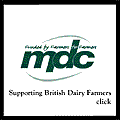Preventing calf scour
| The NADIS disease forecast is based on detailed Met Office data, and regional veterinary reports from 37 farm animal practices and the large animal units at six UK veterinary colleges. NADIS data can highlight potential livestock disease and parasite incidences before they peak, providing a valuable early warning for the month ahead. |
NADIS disease bulletins are written specifically for farmers, to increase awareness of prevalent conditions and promote disease prevention and control, in order to benefit animal health and welfare. Farmers are advised to discuss their individual farm circumstances with their veterinary surgeon.
May 2005
Richard Laven PhD BVetMed MRCVS
Preventing Calf Scour
Calf scour is the most important disease problem in dairy calves and causes more financial loss to the calf producer than any other syndrome. Rotavirus is most common cause of diarrhoea, with over 30% lab diagnoses being rotavirus. The virus is present on nearly every farm so virtually all calves are at risk, though the risk is highest on farms where other agents, particularly E. coli, coronavirus and cryptosporidia, are present. These agents often combine with rotavirus to cause more severe diarrhoea than either would on their own. Controlling rotavirus can thus significantly reduce your losses due to calf scour even if you have other problems on farm.
There are two keys to preventing rotavirus and other scour problems:- maximising hygiene and making the most of colostrum.
Hygiene
Good hygiene reduces the spread of disease between calves. Ensure that bedding is clean and dry, don’t mix different ages of calves, remove sick calves to a sick pen as soon as possible (and don’t return them to their old group) and above all use an all-in, all-out policy with disinfection between groups.
Colostrum
Colostrum is the key to immunity in the young calf. Colostrum contains both antibodies which protect against specific diseases, such as rotavirus, and non-specific protective systems such as lactoferrins which prevent bacterial growth. Ensuring that the calf receives sufficient colostrum (at least two litres within six hours of birth) is vital in the control of calf diarrhoea. It’s best if the calf gets its colostrum by sucking its mother as this ensures that it absorbs the maximum amount of antibodies. Bucket or bottle feeding colostrum results in fewer antibodies being absorbed; stomach tubing is even less efficient, so should only be used as a last resort for calves too weak to suck. A second feed of colostrum in the first 24 hours is also important in maximising the value of the first feed, so if possible leave calves with their mothers for at least 24 hours. The protection from the first dose of colostrum lasts for only three to four days, whereas rotavirus and other infections can occur at any time in the first few weeks, so in order to prevent scour, continued colostrum feeding (at least 2.5 litres every day for two to three weeks) is important. This is because although the antibodies in the colostrum will no longer be absorbed they remain in the gut and can thus prevent gut infections such as rotavirus. If you do feed colostrum for three weeks you will need to store it. There are lots of different ways of doing this with freezing being the simplest. If you do store colostrum make sure that you separate day 1 and 2 colostrum from day 3 and 4 as earlier colostrum has many more antibodies. If early colostrum is in short supply it should be preferentially fed to the younger calves.
Vaccination
The level of antibodies in colostrum depends on what the cow has been exposed to (and how long ago the exposure was). Vaccinating pregnant cattle between one and three months before calving will significantly increase the amount of antibodies in colostrum. This means that the colostrum produced by vaccinated cows can have antibody levels high enough to protect the calf from rotavirus for seven days if two litres of colostrum are given within 12 hours of birth. However the best value for vaccination is obtained when colostrum from vaccinated cattle is fed to calves for at least two weeks after birth (and preferably longer), so that the calf continues to have high levels of protective antibodies in the gut during the critical period.
Follow-up
If despite good hygiene and apparent good intakes of colostrum from vaccinated cattle you still get calf scour then get your vet involved. Further testing is likely to be necessary. Firstly, you need to check that your calves are getting enough antibodies from colostrum; as even on well run farms over 20% of calves can end up with inadequate antibody levels. This can be done with a simple blood test and if low antibody levels are detected your vet can investigate why this is the case. Secondly the vet will need to take several samples from scoring calves to identify what the underlying problem is and to rule out either a problem with vaccination or the presence of other organisms (such as Salmonella)
Copyright © NADIS 2005
www.nadis.org.uk
While every effort is made to ensure that the content of this forecast is accurate at the time of publication, NADIS cannot accept responsibility for errors or omissions. All information is general and will need to be adapted in the light of individual farm circumstances in consultation with your veterinary surgeon
| FURTHER INFORMATION | SPONSORS’ LINK |
| • To find out more about lungworm, click here |
|
| FURTHER INFORMATION | SPONSORS’ LINK |
• If you want to know more about foul in the foot |
| SPONSORS’ LINK | |
| Supporting British dairy farmers |
| FURTHER INFORMATION | SPONSORS’ LINK |
| • Supporting British Livestock click here |
|



